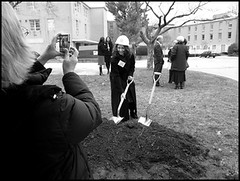From the Collections: Dr. Amy Kaukonen
 We had what turned out to be a fascinating research request for a 1915 Woman's Medical College graduate about whom we had only a small amount of information, but we discovered considerably more in the New York Times online archive and elsewhere. We did have a few photos, notes and some general information from her file, but the story became particularly exciting after she left Philadelphia. First, however, here's what we found on our end:
We had what turned out to be a fascinating research request for a 1915 Woman's Medical College graduate about whom we had only a small amount of information, but we discovered considerably more in the New York Times online archive and elsewhere. We did have a few photos, notes and some general information from her file, but the story became particularly exciting after she left Philadelphia. First, however, here's what we found on our end:
Amy Kaukonen arrived at WMC in September, 1911, to begin medical school; she came straight from high school in Conneaut, Ohio. Fellow students that year hailed from all across the United States as well as Canada, India, Puerto Rico, Russia and other more distant lands (as evidenced by the matriculation book all students signed). Some had undergraduate degrees, others were high school graduates like Kaukonen and a few already held medical degrees from other institutions.
Apparently Kaukonen made an early mark as extremely studious; the 1911 yearbook offered this couplet for the young freshman:
K stands for Kaukonen, with piles of hair so light;At some point in 1913 or 1914, she had to take time off due to illness; as a result she was moved into the 1915 graduating class, but the details are a bit vague – there’s just a quick mention of the event in the student magazine (PDF - see page 20), and then she next appears in her graduation photo in 1915 (she's number 21). She remained in Philadelphia to complete her residency at the Woman's Hospital of Philadelphia, and then vanished from our records. When she resurfaced a few years later, she generated national headlines.
She grinds so hard, that she forgets to go to bed at night
In 1921, just months after the 19th Amendment was passed, Dr. Amy Kaukonen was elected mayor of Fairport Harbor, Ohio - becoming one of the first female mayors in the United States. Her platform was largely Prohibitionist, apparently informed by her experiences as a doctor treating victims of moonshiners and bootleggers (a particular concern for the town, given its location on Lake Erie). Upon her election, she received a congratulatory telegram from President Harding and became known nationwide as the glamorous 'Girl Mayor' (although her age seems to vary depending on the newspaper - it's given as anywhere from 22-28 in a number of 1922 articles, but it seems most likely she was actually 31 at the time). Despite the publicity, her job was not smooth sailing - she was assaulted at work and eventually decamped with little notice to Seattle (according to further contemporary news reports kindly forwarded to us by our researcher). There is speculation that the sudden move may have been the result of threats from bootleggers, but we don't have much concrete evidence to go on - it's certainly a possibility.
It seems Kaukonen later returned to Ohio, where she lived out of the spotlight and continued to practice medicine; she married in the 1930s but never had children (laying to rest the rumor that she was the grandmother of Jourma Kaukonen of Hot Tuna fame). We hope our friends at the Finnish Heritage Museum continue to fill in the blanks and keep us posted on their ongoing research.






